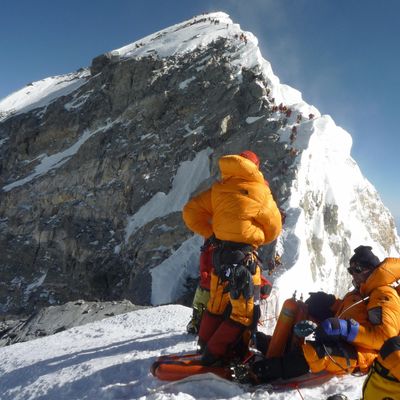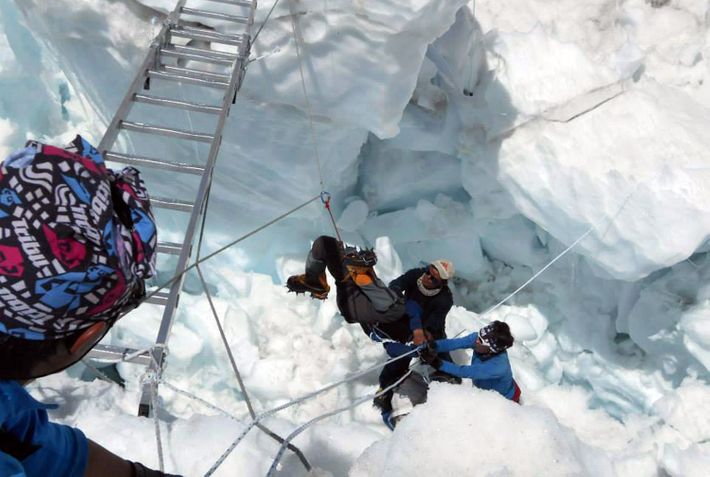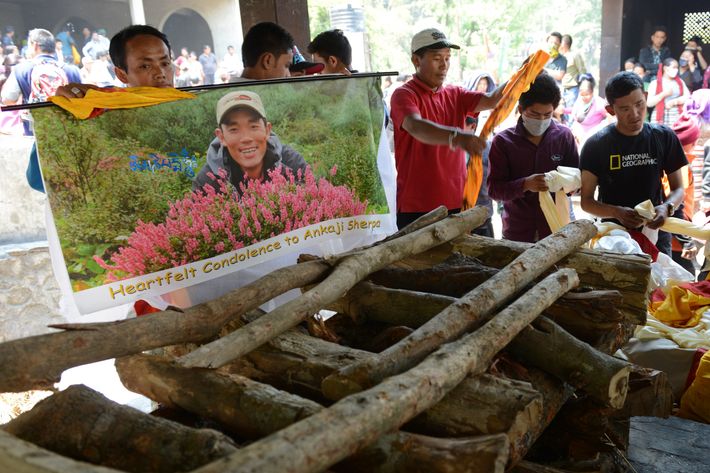
While it remains unclear if Mount Everest will be officially closed for the 2014 season, in the past few days, climbers have been leaving in droves. Following the death of 16 Sherpa guides in an avalanche last Friday, most of their colleagues have refused to work, out of both respect and a fear of more avalanches. The incident has also brought ongoing complaints about the Sherpas’ dangerous work and relatively low pay to a head. Many foreign climbing teams have responded by cancelling their expeditions, though tourists spend years preparing for the trip and spend up to $100,000 to scale the world’s tallest peak. About 40 teams were preparing to climb Mount Everest this season, according to The Wall Street Journal, but a Nepalese official said eight teams had called off their plans by Thursday evening. He added that of the remaining teams, “most of them are in the mood to quit.” Here’s a look at why Mount Everest is essentially shutting down, and the reactions of both Sherpas and foreign mountaineers.
Who are the Sherpas?
They are a Nepalese ethnic group of about 150,000, renowned for their mountaineering abilities (to the point that the name is used to refer to guides who are not members of the ethnic group). Sherpas are usually assigned the most difficult work on the mountain, including hauling gear, setting up camp, and securing ropes and ladders. It’s hard to even watch this video of a climber crossing a crevasse in the Khumbu icefall on three rickety metal ladders, and as the Washington Post notes, “That ladder was almost likely fixed there by Sherpa guides.”
While a Western guide can make about $50,000 per season, Sherpas earn about $2,000 to $5,000 per season, with bonuses if they reach the summit. That’s far more than the $48 average monthly salary in Nepal, but the job is also tremendously dangerous. In an article on Sherpas published last year in Outside, Grayson Schaffer wrote:
A Sherpa working above Base Camp on Everest is nearly ten times more likely to die than a commercial fisherman—the profession the Centers for Disease Control and Prevention rates as the most dangerous nonmilitary job in the U.S.—and more than three and a half times as likely to perish than an infantryman during the first four years of the Iraq war.
What happened last week?
Around 6:30 a.m. on Friday, April 18, there was an avalanche on the mountain’s southern side that killed 16 Sherpas who were tethered to ropes, preparing the route for mountaineers. Thirteen bodies were recovered, and three others were buried under the debris and may never be found.
This was the worst single day accident in the history of Everest. Between 2000 to 2010 only six Sherpas died on the mountain. The number of fatalities was increasing even before last week’s tragedy, with seven Sherpas dying during climbs in 2012 and 2013. The recent increase in fatalities may be due to more people climbing the mountain.
Survivor Jeremy Hanke described the scene to CNN:
Earlier this week, guide Tulsi Gurung explained the Sherpas’ decision to abandon this year’s climbing season. “We had a long meeting this afternoon and we decided to stop our climbing this year to honor our fallen brothers. All sherpas are united in this,” he told AFP. “Some guides have already left and others will take about a week to pack up everything and go.”
How did the government react?
Nepal earns roughly $3.5 million annually in Everest climbing fees, and even more from related tourism, so Sherpas were furious when the government offered only $408 in compensation to the families of the victims. They said they deserve more insurance money, new regulations, and more aid for the families of men injured and killed on the mountain.
On Wednesday, officials suggested there were a few “hooligans” stirring up trouble, but the mountain would remain open. “The Sherpa community, the guides, they will be ready to continue the climbs,” said Maddhu Sudan Burlakoti, a Nepalese tourism official. “Because of the avalanche they are missing their relatives. It is a big shadow. In a few days, they will recover.”
However, by Thursday the number of people at the base camp had already fallen from about 600 to 100. Following a meeting between government officials, Sherpas, and tour operators at Everest base camp, Nepal’s tourism ministry said expeditions should proceed. It also announced this season’s climbing permits, which cost between $25,000 and $150,000, will be valid for five years.

How did the Sherpas react?
Tenzing, a 23-year-old Sherpa, told the Associated Press that 2014 was a “black year” for Everest. “Many of us think this year is not good for climbing and nobody should be going up the mountain at all,” he said. “It was bad beginning to the climbing season and it should not get worse.”

“It is just impossible for many of us to continue climbing while there are three of our friends buried in the snow,” said guide Dorje Sherpa. “I can’t imagine stepping over them.”
According to the New York Times, some say Sherpas who want to keep working are being pressured by the community, and the situation is growing tense. “There was a veiled threat (or rumour of one) that if we go in the icefall we might not be safe,” British expedition leader Tim Mosedale said in a blog post. “Sherpas are being told that if they go on the hill, well, ‘we know where you live.’ Sherpas are turning against Sherpas and in this country where these threats are sometimes carried out they are taken very, very seriously.”
How did the foreign climbers react?
For the most part, they’ve expressed sympathy and appreciation for the Sherpas, though in many cases they’re missing a once in a lifetime opportunity.
“It is a bitter, bitter disappointment,” said James Brooman, a 34-year-old British investment banker told the Times. “I’m probably worse off than most in some ways, since I quit my job and my apartment to do this, so to leave here with a shattered dream — no job, a lot less money and no real home — it’s tough.”
Jon Reiter, a 49-year-old climber from California, was planning to spread his brother’s ashes at the summit, but said witnessing the accident made him reconsider the risks of mountaineering. “I have a great plan,” he said. “I am going to go home and hug my 12-year-old. I’ve seen numerous things in my life, but nothing was ever driven home as to watch those guys on cables being brought down.”






























